Arménsko – krajina dobrých ľudí a výborného jedla
Pozývame vás na spoznávanie jedinečnej prírody a kultúrneho dedičstva Arménska spolu s účastníkmi umelecko-expedičnej expedície Travedding, organizovanej v rámci projektu Kreatívne hory v dňoch 2. – 9. septembra 2023.
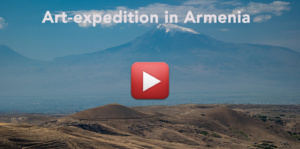 Umelecká expedícia sa začala celodenným poznávaním jedinečnej prírody a kultúrneho dedičstva Arménska. Po opustení rozpáleného hlavného mesta a zastávke pri pamätníku Charencov oblúk bolo z pohľadu na krajinu jasné, že vstupujeme do iného typu sveta, akoby sme unikali zo súčasnosti.
Umelecká expedícia sa začala celodenným poznávaním jedinečnej prírody a kultúrneho dedičstva Arménska. Po opustení rozpáleného hlavného mesta a zastávke pri pamätníku Charencov oblúk bolo z pohľadu na krajinu jasné, že vstupujeme do iného typu sveta, akoby sme unikali zo súčasnosti.
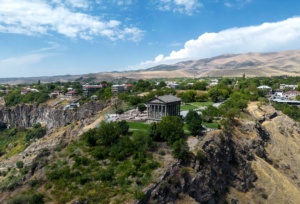 Prvá zastávka – stredoveký kláštor Geghard (zapísaný na zozname svetového dedičstva UNESCO) s horskou kulisou a volskými spevníkmi vyžaruje atmosféru zašlých čias. Nemenej fascinujúce je aj neďaleké mestečko Garni s pevnosťou na vrchole kopca, ktorej dominuje obnovený chrám.Po tom, čo sme si na obed vychutnali chutné arménske jedlo s výhľadom na chrám a hory, nás za rohom čakalo ďalšie prekvapenie. Zostúpili sme do rokliny pod pevnosťou vymodelovanej neobyčajnými čadičovými stĺpmi, ktoré miestni obyvatelia výstižne nazývajú symfónia kameňov.
Prvá zastávka – stredoveký kláštor Geghard (zapísaný na zozname svetového dedičstva UNESCO) s horskou kulisou a volskými spevníkmi vyžaruje atmosféru zašlých čias. Nemenej fascinujúce je aj neďaleké mestečko Garni s pevnosťou na vrchole kopca, ktorej dominuje obnovený chrám.Po tom, čo sme si na obed vychutnali chutné arménske jedlo s výhľadom na chrám a hory, nás za rohom čakalo ďalšie prekvapenie. Zostúpili sme do rokliny pod pevnosťou vymodelovanej neobyčajnými čadičovými stĺpmi, ktoré miestni obyvatelia výstižne nazývajú symfónia kameňov.
Popri tomto neobyčajnom diele prírody poskytujú chránené hory priestor pre hniezdenie dravých vtákov. Mali sme šťastie vidieť hniezdo veľmi vzácneho supa egyptského. 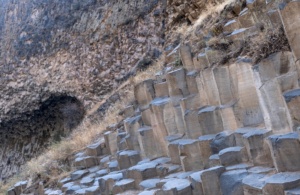 Deň sme ukončili skvelou večerou a tradičnou arménskou hudbou a tancami v taverne Jerevan.
Deň sme ukončili skvelou večerou a tradičnou arménskou hudbou a tancami v taverne Jerevan.
Aj keď je Arménsko známe svojimi stredovekými kláštormi na skalnatých výbežkoch obklopených horami, treba si všimnúť, že podnebie spolu s úrodnou sopečnou pôdou tvoria vynikajúcu kombináciu na výrobu chutných vín, sladkého ovocia a rôznych druhov zeleniny. Keď sme teda cestovali údolím Ararat, vedľa kláštora Khor Virap sme objavili ďalšie dva poklady. Prvým je mokraď Khor Virap kontrastujúca s okolitou suchou pôdou. Mokraď zničená počas socializmu sa obnovuje a vzniká tu náučný chodník. Miesto je dôležité pre miestnu klímu a pre vtáctvo. Mali sme šťastie pozorovať bahniaka, kane čierne či rybárika fúzatého.

Ďalšie prekvapenie nás čakalo v dedinke Pokr Vedi, kde žije Harutyun Hovhannisyan s rodinou a v stopách svojho starého otca vyrába tradičné vína a ovocné likéry. Po tom, čo sme sa naučili pripraviť tolmu (mleté mäso zabalené do hroznových listov), sme si ju dali ako pohostenie na obed s ochutnávkou vína v jeho chladnej modernej pivnici ukrytej pred pražiacim slnkom.Poslednou zastávkou bolo údolie Noravank s Magellanovou jaskyňou a stredovekým kláštorom Noravank zasadeným do nádherných hôr.
Tretí deň umeleckej expedície v Arménsku nás zaviedol do málo známej dedinky Yeghegis, ktorá sa nachádza v nádhernej horskej scenérii. Ubytovali sme sa v hoteli Arevi, ktorý z lodných kontajnerov postavil známy muţ, ktorý sa rozhodol zaloţiť malý hotelový podnik na podporu ekoturizmu v miestnej komunite. Okrem prvkov udržateľnosti, ako je využívanie solárnej energie, hotel ponúka aj vlastné lahodné víno a potraviny vyrobené miestnymi dedinčanmi.
Po rannom pozorovaní divej prírody z hotelovej terasy sme sa rozdelili na dve skupiny. Prvá skupina pešo preskúmala okolité hory po dobre udržiavaných chodníkoch a vydala sa k impozantnej pevnosti Smbataberd.
Druhá skupina sa vybrala autom k atraktívnemu vodopádu Jermak. Večer sme sa dozvedeli o NABU Arménsko a jej aktivitách, keďže je organizátorom umeleckej expedície. Potom sme mali možnosť dozvedieť sa od miestnych, ako sa vyrába tradičný chlieb lavaš. Deň sme ukončili živou hudbou a chutnaním vína.
Štvrtý deň umeleckej expedície bol opäť slnečný. Vyzerá to tak, že v Arménsku neprší často. Rozlúčili sme sa s dedinou Yeghegis a vyrazili sme po veľkolepej ceste, aby sme prekročili Selimský priesmyk vo výške 2400 m. n. m.. Priesmyk bol kedysi súčasťou starobylej Hodvábnej cesty, čo nám pripomína dodnes stojaca historická budova Selimského karavanseraja – niekdajšieho miesta odpočinku kupcov a obchodníkov, ktorí tadiaľ prechádzali so svojimi koňmi a ťavami.
Za priesmykom sa krajina mení, keď vchádzame na horskú plošinu, v ktorej dominuje veľké jazero Sevan a nečinná sopka Argmaghan. Tu pôjdeme najprv do dediny Horatus blízko brehu jazera. Je to staré miesto, dnes navštevované najmä kvôli najväčšiemu cintorínu s arménskymi chačkarmi – pôsobivými dômyselne vyrezávanými pamätnými stélami s krížom.
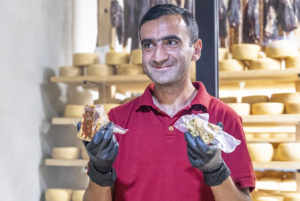 V Noratuse je však ešte jedna zaujímavosť, kvôli ktorej sme sem prišli – syráreň rodiny Mikayelyanovcov. Na svete nie je veľa miest, kde môžete ochutnať kvalitný syr vyrobený z araratskej pálenky, vína alebo horských bylín. Bol to skutočný pôžitok pre chuťové poháriky v ústach, keď sme ochutnali 10 rôznych druhov domáceho vyzretého syra v kombinácii s miestnym ovocím, údenou šunkou, chlebom lavaš a vínom. Degustačný zážitok pripomínal pomalú ochutnávku jedál v Rakúsku alebo Taliansku.
V Noratuse je však ešte jedna zaujímavosť, kvôli ktorej sme sem prišli – syráreň rodiny Mikayelyanovcov. Na svete nie je veľa miest, kde môžete ochutnať kvalitný syr vyrobený z araratskej pálenky, vína alebo horských bylín. Bol to skutočný pôžitok pre chuťové poháriky v ústach, keď sme ochutnali 10 rôznych druhov domáceho vyzretého syra v kombinácii s miestnym ovocím, údenou šunkou, chlebom lavaš a vínom. Degustačný zážitok pripomínal pomalú ochutnávku jedál v Rakúsku alebo Taliansku.
Posledným miestom na programe, ktoré sa stále nachádza v nadmorskej výške 2000 m, je Tatojanov mlyn v Nerkin Getašene. Obnovený mlyn so zelenou strechou je stále v prevádzke a dokáže mlieť pšenicu na múku tradičným spôsobom, jeho mlecie kamene sa otáčajú silou tečúcej vody. Rodina vlastniaca historický mlyn prevádzkuje aj pekný penzión so záhradou na oddych. Po tom, čo sme si pozreli, ako mlyn funguje, sme mali možnosť pozorovať, ako sa vyrába sladký chlieb nazývaný gata. Samozrejme, že sme ho mohli ochutnať, keď bol upečený. Bol výborný.
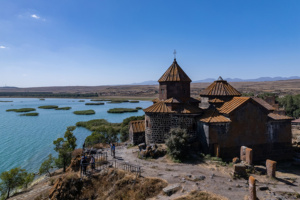 Piaty deň umeleckej expedície sa začal výdatnými raňajkami z miestnych produktov v mlyne Tatoyan.Dnešný hlavný plán je preskúmať Sevanské jazero – najväčšiu sladkovodnú vodnú plochu v oblasti Kaukazu s lákavou tyrkysovo modrou vodou a štatútom národného parku. Dopoludnia sme si užili pozorovanie vtákov na jeho západnom brehu, popoludní sme strávili čas pri starom kláštore Sevanavank a jeho pozoruhodnom okolí.
Piaty deň umeleckej expedície sa začal výdatnými raňajkami z miestnych produktov v mlyne Tatoyan.Dnešný hlavný plán je preskúmať Sevanské jazero – najväčšiu sladkovodnú vodnú plochu v oblasti Kaukazu s lákavou tyrkysovo modrou vodou a štatútom národného parku. Dopoludnia sme si užili pozorovanie vtákov na jeho západnom brehu, popoludní sme strávili čas pri starom kláštore Sevanavank a jeho pozoruhodnom okolí.
Potom nás trasa viedla cez tunel do oblasti Tavuš, kde suchú step okolo jazera Sevan vystriedali bujné zalesnené kopce. Táto pekná oblasť je ďalším národným parkom a naša prvá zastávka bola v dedine Aghavnavank (v preklade kláštorná dedina s holubmi) v penzióne s názvom Aghavnatun (čo znamená dom s holubmi).
Majiteľ penziónu je zároveň vinár, ktorý vyrába špeciálne vína z ručne zbieraných pôvodných arménskych druhov hrozna. Možno sa čudujete, prečo sa v miestnych názvoch používa holub. Jeho odpoveď znela, že holub symbolizuje mier a mier je potrebný v Arménsku, na Ukrajine a všade na svete.
Šiesty deň umeleckej expedície bol venovaný zelenému srdcu Arménska, ktoré je pre návštevníkov známe ako národný park Dilijan.
Deň sme začali objavením starobylého kláštora Haghartsin (jeho názov znamená hniezdo orlov), ktorý je zasadený do bujných listnatých lesov v horách. Uprostred parku sme navštívili aj jazero Parz obklopené starými lesmi, žiaľ, oblasť sa zmenila na komerčnú a slúži skôr na zábavu ako na pokojný únik do prírody.
Divokejším miestom pre nás bola štátna svätyňa Ijevan s úžasnou horskou scenériou a divou prírodou. Večer patril miestnej hudbe a gastronómii. Strávili sme ho v dedinke Jenokavan v gastrodvorci a penzióne Berkri s rodinou majiteľa. Mali sme možnosť upiecť si pravý arménsky chlieb, ochutnať miestne víno a jedlo v sprievode príjemnej živej hudby v podaní talentovanej skupiny Hatik.
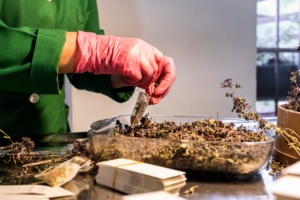 Siedmy deň umeleckej expedície pokračoval výletom do Tavuš – dediny v severovýchodnom cípe Arménska. Prvýkrát sa objavil dážď a hmla. Táto zmena počasia nám však nemohla pokaziť dobrú náladu. Po príchode do Tavuš nás srdečne privítal Gnel Nazanyan, ktorý v dedine vytvoril úspešnú firmu na výrobu bylinkového čaju a dáva prácu miestnym ľuďom. Čajové výrobky nesú názov Darman – čo znamená liek, pretože bylinkové nálevy dokážu liečiť telo aj dušu. Je však dôležité vedieť, ako čaj správne piť. Preto sme boli zasvätení do toho, ako si ho vychutnať, čajovým obradom na brehu horskej rieky. Po vychutnaní lahodného čaju nás Gerel všetkých pozval na grilovanú večeru a nápoje. Niet divu, že darmanské čaje sú žiadané a vyvážajú sa do mnohých krajín, pretože ako sme boli svedkami, sú vyrábané so starostlivosťou a láskou.
Siedmy deň umeleckej expedície pokračoval výletom do Tavuš – dediny v severovýchodnom cípe Arménska. Prvýkrát sa objavil dážď a hmla. Táto zmena počasia nám však nemohla pokaziť dobrú náladu. Po príchode do Tavuš nás srdečne privítal Gnel Nazanyan, ktorý v dedine vytvoril úspešnú firmu na výrobu bylinkového čaju a dáva prácu miestnym ľuďom. Čajové výrobky nesú názov Darman – čo znamená liek, pretože bylinkové nálevy dokážu liečiť telo aj dušu. Je však dôležité vedieť, ako čaj správne piť. Preto sme boli zasvätení do toho, ako si ho vychutnať, čajovým obradom na brehu horskej rieky. Po vychutnaní lahodného čaju nás Gerel všetkých pozval na grilovanú večeru a nápoje. Niet divu, že darmanské čaje sú žiadané a vyvážajú sa do mnohých krajín, pretože ako sme boli svedkami, sú vyrábané so starostlivosťou a láskou.
Ráno ôsmeho dňa umeleckej expedície nás zobudil dážď. Dodržali sme však náš program a navštívili starý tisový háj neďaleko dediny Aghavnavank. Aby sme nemuseli chodiť po špinavej ceste, k unikátnemu lesu nás trochu bizarným spôsobom priblížila stará ruská terénna dodávka UAZ. Predtým, ako sme si pozreli vzácne tisy, ktoré vo voľnej prírode zriedkavo rastú v takom počte a veku, sme prešli popri starom kostole svätého Astvatsatina, kde sme stretli mladého kňaza, ktorý nám dal požehnanie. Neďaleko kamenného kostola v lese prevláda tmavšie ihličie tisov – niektoré z týchto stromov sú staršie ako 300 rokov. Je to skutočný prírodný poklad Arménska.
Pred odchodom do Jerevanu sme sa naobedovali v dome kuchára v Čagkunku. Je to ďalší príklad toho, ako kuchár s medzinárodnými skúsenosťami dokáže vytvoriť gastronomické útočisko ďaleko od mesta na základe miestnych kvalitných potravín a úžasných receptov. Svoje zručnosti nám predviedol prípravou záhradného šalátu, teda čerstvého šalátu z červenej repy, hrušiek, rukoly a ďalších surovín z jeho záhrady. Deň v Jerevane sme zavŕšili rozlúčkovou večerou v taverne na brehu rieky so živou hudbou a tancom.
Bola to úžasná umelecká expedícia.
 Spolufinancované Európskou úniou
Spolufinancované Európskou úniou
Tento článok vznikol s finančnou podporou Európskej únie. Vyjadrené názory a stanoviská sú však len názormi autora Jozefa Bednara a nemusia nevyhnutne odrážať názory a stanoviská Európskej únie alebo Európskej výkonnej agentúry pre vzdelávanie a kultúru (EACEA). Európska únia ani EACEA za ne nenesú zodpovednosť
Foto a video: Jakub Antypenko


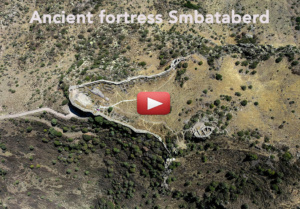
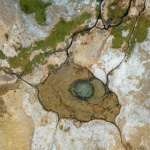 Previous Post
Previous Post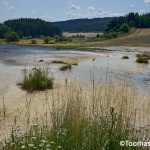 Next Post
Next Post